Voyages to the Comets and Asteroids
Until the 1980s, most theories about the composition and other physical characteristics of asteroids and comets could not be verified because no one had ever seen one of these bodies up close. Astronomers who studied them had to rely on images taken by ground-based telescopes. Even the largest telescopes revealed no distinct visual details, mainly because both asteroids (with the exception of Ceres) and comets are relatively tiny objects. And of course, they are also very far away. An astronomer on Earth trying to make out details on a one-mile-wide asteroid in the asteroid belt faces the same challenge as a person in New York trying to read words painted on a basketball in California.
Clearly, scientists realized, the only way they could solve the long-standing mysteries surrounding comets and asteroids would be to send spacecraft to study these objects up close. The first Earth probes to reach these objects were launched in the 1980s. And by 2003, more than a dozen spacecraft had flown by, orbited, or landed on one or more asteroids or comets. The information gathered during such exploratory missions has greatly expanded scientific knowledge of these important cosmic bodies. Many questions remain. But scientists are confident they will be answered by a number of other probes, some of which have already been launched.
The Pioneers
Today's asteroidal and cometary probes are all complex, sophisticated devices packed with state-of-the-art sensors, cameras, computers, and other instruments. In comparison, the first spacecraft to gather data about asteroids were much simpler and more technologically primitive. These craft, dubbed Pioneer 10 and Pioneer 11, were not designed to photograph or analyze any asteroids. Instead, they were intended primarily to explore the region around Jupiter. A secondary
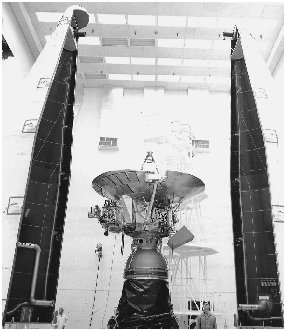
Pioneer 10 was launched in March 1972, and by July of that year it reached the asteroid belt. It carried two instruments designed to measure and record impacts of dust and tiny meteors (pieces of disintegrated asteroids and comets) both before and after entering the belt. The first of these instruments, Curtis Peebles explains,
consisted of thirteen panels with 234 pressurized cells [each containing a gas]. . . . When a cell was hit by a meteor, the skin would be penetrated and the gas would leak out. Pioneer 10 had thin-walled cells; Pioneer 11's cells had a thicker skin, which allowed detection of only larger particles. The second experiment used a meteor-asteroid detector, a package of four telescopes that would detect the light reflected from a particle. . . . When any three of the telescopes saw an object, the experiment logged an event [i.e., an impact]. The object's relative size, distance, trajectory [direction of movement], and velocity could be calculated. 33
During the journey to the asteroid belt, as Pioneer 10 moved through ordinary space, the instruments counted roughly forty small impacts. In comparison, forty-two impacts occurred while the craft was inside the belt. Pioneer 11, which launched in April 1973, recorded only seven small impacts inside the belt. These simple but effective experiments showed that the asteroid belt is not densely packed with debris and therefore is not unduly dangerous to human spacecraft.
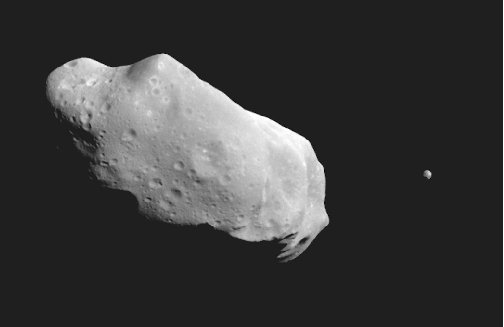
The Galileo Mission
Though the Pioneer probes answered one important question about asteroids, many other questions remained. The next logical step was to fly by a large asteroid, photograph it, and send the pictures, via electronic signals, back to Earth. The first spacecraft to accomplish this feat was named Galileo. Launched by NASA from the orbiting space shuttle Atlantis in October 1989, the craft flew near two asteroids—Gaspra and Ida.
The Gaspra flyby took place in October 1991. Onboard cameras revealed an irregularly shaped object measuring roughly twelve by seven miles and pitted by close to forty large impact craters. These craters, along with several plainly visible fracture lines, suggest that Gaspra survived a major collision with another asteroid. Mission scientists estimated that the collision occurred between 300 and 500 million years ago. Other onboard instruments confirmed that the asteroid is S-type, composed of metal-rich rock.
Galileo's rendezvous with Ida took place in August 1993. Onboard cameras snapped about 150 photos in just under six hours, showing an uneven-shaped object about thirty-five miles long. The biggest surprise of the flyby, of course, was the discovery of Ida's moon, Dactyl. (Scientists initially called it "Baby Ida," but soon gave it the official title of Dactyl, after the Dactyls, magical beings who lived on Mount Ida in Greek mythology.)
At first, the existence of this asteroidal moon puzzled NASA scientists. They were fairly sure that Ida and Dactyl are fragments of a larger ancient asteroid that broke up in a collision event. If so, Peebles asks, "How could one body have ended up in orbit around another following such an event?" The scientists speculated, he says,
that when the original body shattered, some of the fragments traveled along identical paths, flying side by side. As time passed, their gravitational attraction caused one to go into orbit around the other. Computer modeling indicated that if a 110-kilometer [68-mile] body shattered, there was a 50 percent chance that at least one of the larger fragments would attract a moon. 34
Even as Galileo was investigating Ida and Dactyl, NASA was readying Clementine, a probe designed to fly close to another large asteroid. Clementine launched in January 1994 and headed for its intended target—an NEA named Geographos. Unfortunately, the spacecraft malfunctioned and the mission could not be completed.
Touchdown on an Asteroid
Many scientists felt that to some degree the spectacular success of the next asteroidal mission made up for Clementine's failure. In February 1996 NASA launched NEAR (which stands for Near Earth Asteroid Rendezvous) to study the asteroids Eros and Mathilde. NEAR reached Mathilde, a main belt asteroid, on June 27, 1997. The flyby lasted only twenty-five minutes but went according to plan and provided scientists with a bonanza of data. Onboard cameras showed that the object is potato shaped and measures about thirty-six by twenty-nine miles.
More importantly, it was discovered that Mathilde has an eleven-mile-wide impact crater, a hole bigger than Mount Everest and fully one-third the size of the asteroid itself. When the great comet hunter Eugene Shoemaker saw the first photo of Mathilde, he quipped that "it is more crater than asteroid." 35 Shoemaker and other scientists considered it incredible that the object had managed to survive such a huge impact event.
Leaving Mathilde, NEAR headed for Eros, an NEA, reaching it in December 1998. By this time, the craft had been renamed NEAR-Shoemaker, in honor of Shoemaker, who had tragically died in a car accident in July 1997. The flyby showed that Eros measures roughly twenty-one by eight miles. Also, like Mathilde, it has an unusually large impact crater. The fact that both asteroids visited by a single probe have such big craters suggested to scientists that the materials making up these objects must not be very dense. Denser, harder materials would have cracked and fragmented more easily, whereas less-dense materials would better absorb large shocks.
NEAR-Shoemaker returned in February 2000 and this time went into orbit around Eros. The mission achieved another important milestone when, on February 12, 2001, the intrepid spacecraft became the first ever to land on an asteroid. Carefully guided by scientists on Earth, the probe gently descended toward the surface at about 3.5 miles per hour. Touchdown occurred at 3:02 P . M . Eastern Standard Time. "This was maybe the softest landing of all time," 36 mission director Robert Farquhar observed. The final photos snapped by onboard cameras before
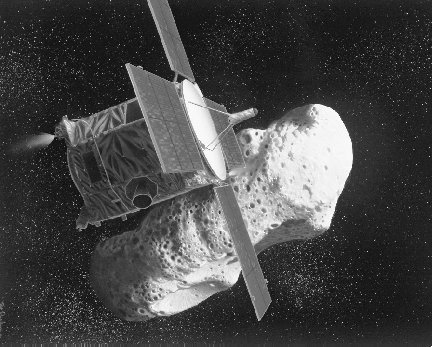
Topography of Asteroids
Still another Earth probe, the Jet Propulsion Laboratory's Deep Space 1 (or DS 1 for short), made it to an asteroid. DS 1 launched in October 1998, and in July 1999 it performed a flyby of the asteroid Braille (named for Louis Braille, inventor of the raised dot system that allows seeing-impaired people to read). This asteroid proved to be a peanut-shaped body measuring about 1.3 by 0.6 miles. From their analysis of Braille's surface materials, mission scientists concluded that it is a fragment that blasted off the larger asteroid Vesta in an ancient collision event.
These close-up studies of Braille, Mathilde, Eros, Gaspra, and Ida have vastly increased scientific knowledge of asteroids. In addition, the many detailed photos taken of their surfaces during these missions will prove valuable to companies that plan to conduct mining operations on these bodies in the next few decades. Indeed, knowing the topography, or the landscape characteristics, as well as the swift rotation periods, of asteroids is vital to such operations. "NEAR-Shoemaker's images of Eros and radar observations of several other small NEAs reveal a veritable zoo of irregular shapes," writes planetary scientist Daniel D. Durda.
Large ejecta blocks [pieces of rock dislodged during collision events], undulating [wavy] plains between overlapping large craters, and ridges and facets that define the overall shape of the asteroid could make for a wildly varying terrain with locally very steep slopes. On worlds the size of small towns, the horizon never lies far away—the vista over the other side of the next hill might well fall away beneath you to encompass the whole other side of the asteroid. Astronauts will also have to deal with rapidly changing lighting conditions. The rotation periods of many small NEAs are only a couple of hours, much shorter than the astronauts' spacesuits should allow them to explore. Surface crews may well witness several sunrises and sunsets during their excursions as they investigate their tumbling mountain. 37
Rendezvous Party at Halley
While the Galileo and Clementine asteroid missions were still in the planning stages, scientists in the United States and other countries were also busy sending spacecraft to rendezvous with comets. The first Earth probe to perform a flyby of a comet was NASA's International Comet Explorer, or ICE
Deep Space 1: On Technology's Cutting Edge
Here, from an article in the April 2002 issue of Astronomy , senior editor Richard Talcott describes the remarkable craft that successfully rendezvoused with Comet Borrelly—NASA's Deep Space 1.
On October 24, 1998, NASA's New Millennium Program got off to a rousing start with the launch of Deep Space 1. NASA designed this program to test cutting-edge technology in space. . . . Designed and built in just three years at a cost of approximately $150 million, the refrigerator-sized spacecraft flight-tested a dozen new technologies. Perhaps the most intriguing was an ion engine, a futuristic system that used . . . atoms [of the gas xenon] instead of standard chemical propellants. The engine created the ions by bombarding xenon atoms with a beam of electrons. It then generated thrust by passing the ions through an electrical field . . . and shooting them out the back of the spacecraft. . . . Among the other technologies used [was] a solar-power system that used cylindrical lenses to concentrate sunlight onto an array of solar cells. . . . Near the end of its primary mission, Deep Space 1 flew past the asteroid Braille. It then embarked on an extended mission that culminated with the Comet Borrelly flyby. . . . Engineers turned off the ion engine on December 18, 2001, though the radio receiver will be left on in case future generations want to contact the spacecraft [which is still in space today].
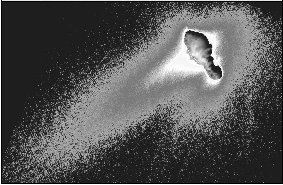
(originally named ISEE-3). Launched in August 1978, ICE reached Comet Giacobini-Zinner in September 1985. The craft first passed about 16,500 miles behind the comet, where it flew through and analyzed the gases and dust making up the tail. Then ICE briefly came within about 4,700 miles of the comet's nucleus before departing for its next and more high-profile cometary encounter.
That second rendezvous was with the most famous of all comets—Halley, which was then making its much publicized 1986 approach to the Sun and Earth. ICE was a latecomer to the Halley rendezvous party, however. The first Earth craft to reach the comet was the Soviet Union's Vega 1, on March 4, 1986, at a distance of about 92 million miles from Earth. Vega 1 got within about 5,300 miles of Halley's nucleus and snapped some photos, which were somewhat fuzzy and indistinct. A few days later, a sister craft, Vega 2, arrived, got a little closer to the comet, and produced better pictures. On March 8 and 11, respectively, two Japanese craft—Suisei and Sukigake—flew by Halley. Then, on March 13, the Soviet and Japanese probes were joined by Giotto, launched by the European Space Agency in July 1985. Giotto came within 373 miles of the comet and conducted its own close-up study, finally followed by ICE on March 28.
These spacecraft not only imaged Halley's nucleus but also analyzed the substances on its surface and in the halo of gas and dust surrounding the comet. For example, science writer William S. Weed points out,
The Vega and Giotto probes found an abundance of water, gases, and primitive grains [pebbles] rich in elements that made up the solar nebula at the time the solar system was forming. The probes also detected complex hydrocarbons, the raw materials for life. Close-up photographs also revealed that
Halley was oddly shaped, not spherical as some had expected, and covered with . . . soot as if it had rolled down a dirty chimney. Astronomers think that [complex] molecules from comets can be deposited on Earth directly via impacts, or from the steady "precipitation" of particles from innumerable comet tails. The "dirty" part of Halley also includes silicate grains similar to what scientists find in meteorites. 38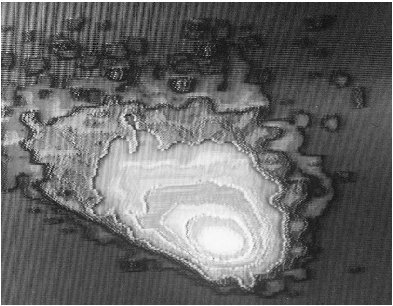 This is the first image of Comet Halley snapped by the European Space Agency's Giotto. Clouds of gas and dust surround the nucleus.
This is the first image of Comet Halley snapped by the European Space Agency's Giotto. Clouds of gas and dust surround the nucleus.
The spacecraft also studied the jets of gases that were shooting out of the comet and forming its tail. Scientists had anticipated that these volatiles would come mainly from the side facing the Sun, since it is presumably the warmth of sunlight that causes ices located near the comet's surface to sublime. And this is indeed what the Halley flybys confirmed. "The bright jets visible in the images," reports John Brandt,
originated from a limited number of locations on the comet's surface (perhaps one-tenth of the total area) and were confined to the sunward side. The jets appeared bright, presumably from sunlight reflecting off particles of dust dragged off the nucleus by the expanding, freshly sublimated gas. 39
A New Generation of Explorers
Adding to the mountain of data gathered by the historic meeting of international spacecraft at Halley in 1986 was that generated by a mission to Comet Borrelly in September 2001. DS 1, which had rendezvoused with the asteroid Braille in 1998, passed within only 1,349 miles of Borrelly's nucleus. The
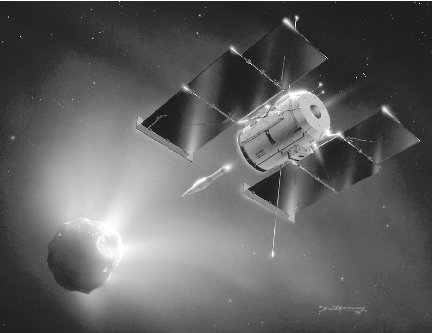
In fact, Borrelly, presumably like most or all comets, features a series of dark, rough-textured surface areas mixed with lighter, smoother ones. The jets forming the comet's tail are emitted from the lighter areas. So scientists think the jets regularly resurface these spots with fresh ices, while the darker areas are probably older, thicker material containing far fewer ices.
The mission to Comet Borrelly was the first of a new generation of cometary and asteroidal explorations slated by NASA for the early years of the new millennium. In 2004 a probe named Stardust will rendezvous with Comet Wild 2 and return to Earth with samples of comet dust. Samples of an asteroid will be gathered in the same manner by the Muses-C craft in 2005. That same year, another probe, Deep Impact, will be the first to land on a comet and use onboard instruments to analyze its ices. And the European Space Agency spacecraft Rosetta will land on and analyze the surface materials of the asteroid Wirtanen in 2011. Meanwhile, NASA's Contour probe will fly by three comets—Encke, Schwassman-Wachmann-3, and d'Arrest—by 2008. Astronomers and planetary scientists are clearly excited about what will surely prove to be a wealth of new knowledge about these surviving remnants of the solar system's violent birth.
Comment about this article, ask questions, or add new information about this topic: